A High-Performance Synthetic Jet Piezoelectric Air Pump with Petal-Shaped Channel
Abstract
:1. Introduction
2. Design and Principle
2.1. Design and Principle of the Piezoelectric Vibrator
2.2. Design and Principle of the Synthetic Jet Piezoelectric Air Pump
3. Prototype Fabrication and Experimental Platform
4. Results and Discussion
4.1. Simulation and Experiment of the Piezoelectric Vibrator
4.2. Experiment Test of the Synthetic Jet Piezoelectric Air Pump
4.3. Structure Optimization
4.4. Simulation and Discussion of the Heat Transfer Characteristics of the Pump
5. Conclusions
- (1)
- (2)
- The performance advantage of the synthetic jet piezoelectric pump with a petal-shaped inlet channel is proven by comparative experiments. Compared with the synthetic jet piezoelectric pump with the direct channel, the flow performance is improved by 43.7%. Compared with the synthetic jet piezoelectric pump with the diffuser/nozzle channel, the flow performance is improved by 13.9% (Figure 9).
- (3)
- Meanwhile, the primary and secondary order of parameters affecting the performance of the synthetic jet piezoelectric pump is obtained by means of variance analysis of the orthogonal test, which is the diameter of the air outlet (), the height of the cavity (), the diameter of the jet hole (), and the height of the chamber () (Table 5).
- (4)
- According to the optimization experiment based on orthogonal design, the parameters of the synthetic jet piezoelectric pump with the best structure are , , , . At the , , the maximum flow rate of the synthetic jet piezoelectric pump with petal-shaped inlet channels is achieved , which is higher than optimized before (Figure 10).
- (5)
- After understanding the operating performance of a synthetic jet piezoelectric pump, the cooling performance of this piezoelectric pump is discussed. The researchers obtained the convective heat transfer coefficient of this device to be 28.8 by means of simulation, demonstrating the cooling capabilities of this device (Figure 12).
Author Contributions
Funding
Institutional Review Board Statement
Informed Consent Statement
Data Availability Statement
Acknowledgments
Conflicts of Interest
Nomenclature
| The concentrated force on a plate at the center of a circle plate, [N]. | |
| The length between any point on the circle plate and the center of a circle plate, [mm]. | |
| The radius of the circle plate, [mm]. | |
| The maximum displacement of the piezoelectric vibrator, [mm]. | |
| The peak-to peak displacement at the center, [mm]. | |
| The stroke length, [mm]. | |
| The stroke length of the whole cycle of a synthetic jet, [mm]. | |
| The average velocity scale for the synthetic jet, [L/s]. | |
| The jet hole diameter of synthetic jet actuator, [mm]. | |
| Strouhal number | |
| The radian frequency of vibrator, [1/s]. | |
| Kinematic viscosity of the fluid, []. | |
| Jet formation constant | |
| T | One cycle period of a synthetic jet, [s] |
| Reynolds number | |
| Stokes number | |
| The instantaneous mass flow rate in orifice area, [kg/s]. | |
| The instantaneous velocity at the jet hole, [L/s]. | |
| The diameter of piezoelectric vibrator, [mm]. | |
| Heat transfer coefficient, | |
| Heat Power, []. | |
| radiating surface, [. | |
| The average surface temperature of the heat resource, []. | |
| Environment temperature, []. |
References
- Qian, J.-Y.; Hou, C.-W.; Li, X.-J.; Jin, Z.-J. Actuation Mechanism of Microvalves: A Review. Micromachines 2020, 11, 172. [Google Scholar] [CrossRef] [PubMed] [Green Version]
- Lee, C.-Y.; Fu, L.-M. Recent Advances and Applications of Micromixers. Sens. Actuators B Chem. 2018, 259, 677–702. [Google Scholar] [CrossRef]
- Li, H.; Liu, J.; Li, K.; Liu, Y. A review of recent studies on piezoelectric pumps and their applications. Mech. Syst. Signal Process. 2021, 151, 107393. [Google Scholar] [CrossRef]
- Doll, A.; Reimers, S.; Heinrichs, M.; Goldschmidtboeing, F.; Schrag, H.-J.; Hopt, U.; Woias, P. A high performance bidirectional micropump for a novel artificial sphincter system. Sens. Actuators A Phys. 2006, 130–131, 445–453. [Google Scholar] [CrossRef]
- Ma, T.; Sun, S.; Li, B.; Chu, J. Piezoelectric peristaltic micropump integrated on a microfluidic chip. Sens. Actuators A Phys. 2019, 292, 90–96. [Google Scholar] [CrossRef]
- Ma, H.-K.; Hou, B.-R.; Lin, C.-Y.; Gao, J.-J. The improved performance of one-side actuating diaphragm micropump for a liquid cooling system. Int. Commun. Heat Mass Transf. 2008, 35, 957–966. [Google Scholar] [CrossRef]
- Wang, X.Y.; Ma, Y.T.; Yan, G.Y.; Huang, D.; Feng, Z.H. High flow-rate piezoelectric micropump with two fixed ends polydimethylsiloxane valves and compressible spaces. Sens. Actuators A Phys. 2014, 218, 94–104. [Google Scholar] [CrossRef]
- Yeom, T.; Huang, L.; Zhang, M.; Simon, T.; Cui, T. Heat transfer enhancement of air-cooled heat sink channel using a piezoelectric synthetic jet array. Int. J. Heat Mass Transf. 2019, 143, 118484. [Google Scholar] [CrossRef]
- Qiu, Y.-L.; Hu, W.-J.; Wu, C.-J.; Chen, W.-F. Flow and heat transfer characteristics in a microchannel with a circular synthetic jet. Int. J. Therm. Sci. 2021, 164, 106911. [Google Scholar] [CrossRef]
- Jabbal, M.; Jeyalingam, J. Towards the noise reduction of piezoelectrical-driven synthetic jet actuators. Sensors Actuators A: Phys. 2017, 266, 273–284. [Google Scholar] [CrossRef] [Green Version]
- Jacob, A.; Shafi, K.; Roy, K.R. Enhancement of heat transfer in a synthetic jet actuated by piston cylinder. Adv. Mech. Eng. 2021, 13, 16878140211049139. [Google Scholar] [CrossRef]
- Jalilvand, A.; Mochizuki, M.; Saito, Y.; Kawahara, Y.; Singh, R.; Wuttijumnong, V. Cooling Performance Evaluation of Synthetic Jet Based Thermal Solution Module. J. Therm. Sci. Eng. Appl. 2015, 7, 031010. [Google Scholar] [CrossRef]
- Liu, C.; Zhu, Y. Simulation and experimental study of direct spray type piezoelectric air pumps based on synthetic jet. Microsyst. Technol. 2019, 25, 4445–4454. [Google Scholar] [CrossRef]
- Liu, C.; Zhu, Y.; Wu, C. Optimization of a synthetic jet based piezoelectric air pump and its application in electronic cooling. Microsyst. Technol. 2020, 26, 1905–1914. [Google Scholar] [CrossRef]
- Le Van, L.; Bui, T.T.; Nhu, C.N.; Ngoc, A.N.; Dinh, T.X.; Dang, L.B.; Tran, C.-D.; Duc, T.C.; Dau, V.T. Simulation and Experimental Study of a Synthetic Jet Valveless Pump. IEEE/ASME Trans. Mechatron. 2020, 25, 1162–1170. [Google Scholar] [CrossRef]
- Tran, C.-D.; Pham, P.H.; Nguyen, T.-K.; Phan, H.-P.; Dinh, T.; Nguyen, T.V.; Bui, T.T.; Chu, D.T.; Nguyen, N.-T.; Dao, D.V.; et al. A new structure of Tesla coupled nozzle in synthetic jet micro-pump. Sensors Actuators A Phys. 2020, 315, 112296. [Google Scholar] [CrossRef]
- Munas, F.R.; Melroy, G.; Abeynayake, C.B.; Chathuranga, H.L.; Amarasinghe, R.; Kumarage, P.; Dau, V.T.; Dao, D.V. Development of PZT Actuated Valveless Micropump. Sensors 2018, 18, 1302. [Google Scholar] [CrossRef] [Green Version]
- Brodetsky, S. Theory of Plates and Shells. Nature 1941, 148, 606. [Google Scholar] [CrossRef]
- Glezer, A. The formation of vortex rings. Phys. Fluids 1988, 31, 3532–3542. [Google Scholar] [CrossRef]
- Smith, B.L.; Glezer, A. The formation and evolution of synthetic jets. Phys. Fluids 1998, 10, 2281–2297. [Google Scholar] [CrossRef]
- Smith, B.L.; Glezer, A. Vectoring of Adjacent Synthetic Jets. AIAA J. 2005, 43, 2117–2124. [Google Scholar] [CrossRef]
- Yogen, U.; Holman, R.; Mittal, R.; Carroll, B.; Sheplak, M.; Cattafesta, L. A Jet Formation Criterion for Synthetic Jet Actuators. In Proceedings of the 41st Aerospace Sciences Meeting and Exhibit: American Institute of Aeronautics and Astronautics, Reno, NV, USA, 6–9 January 2003. [Google Scholar]
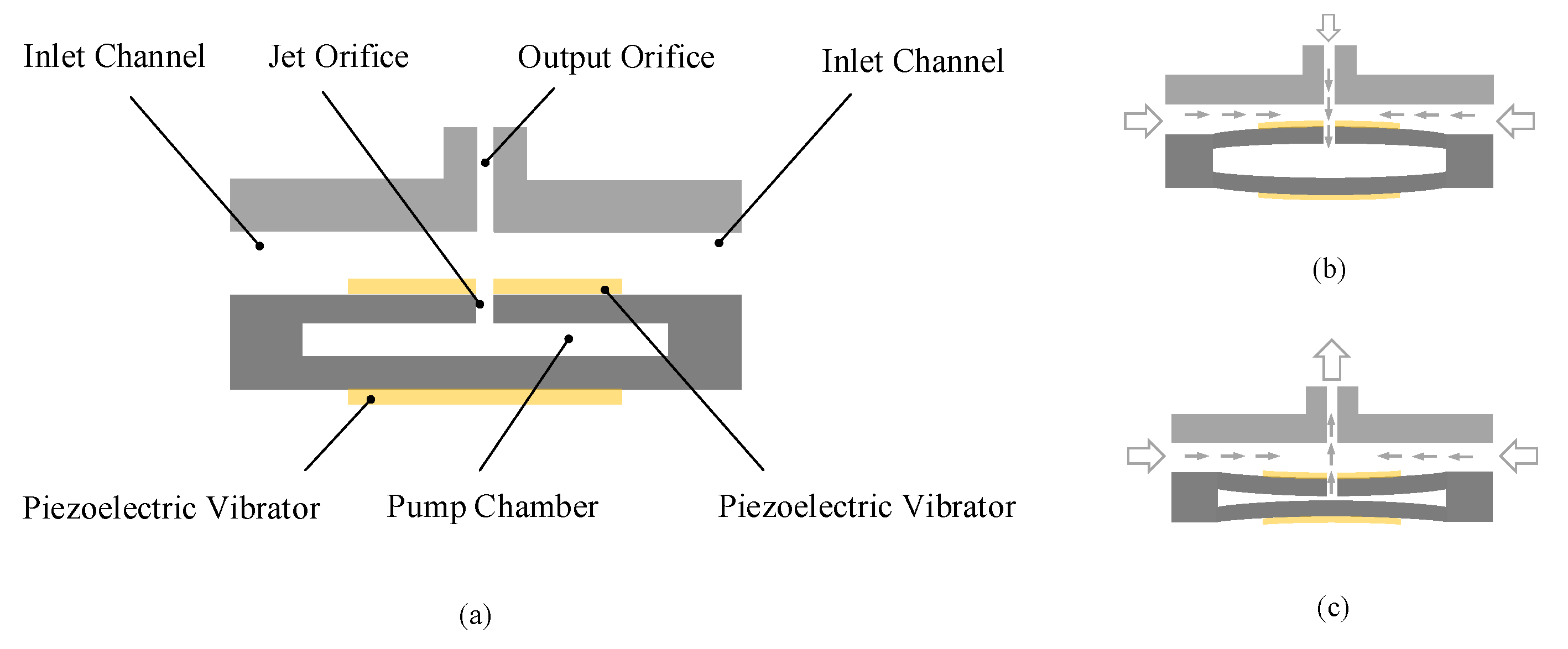
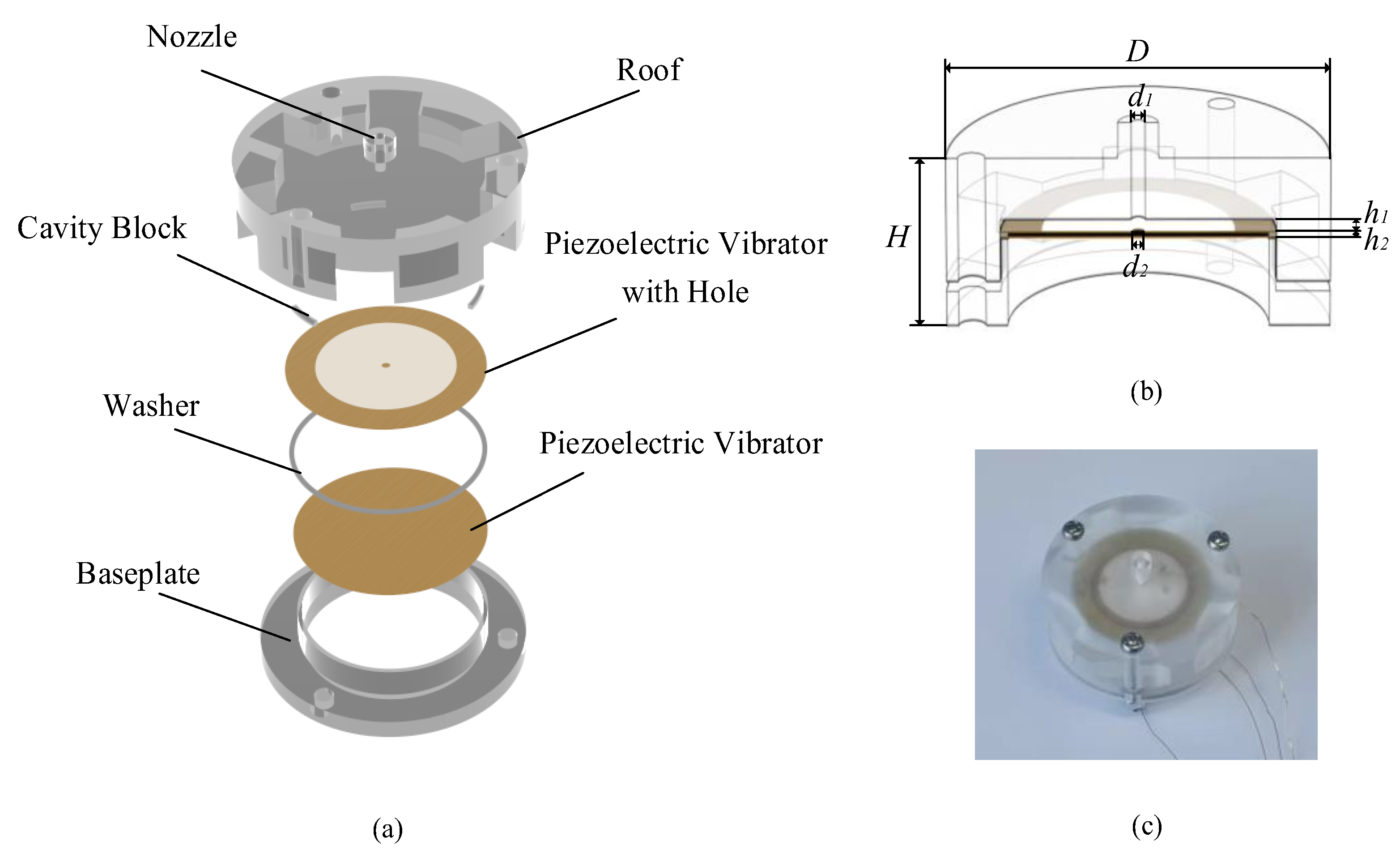

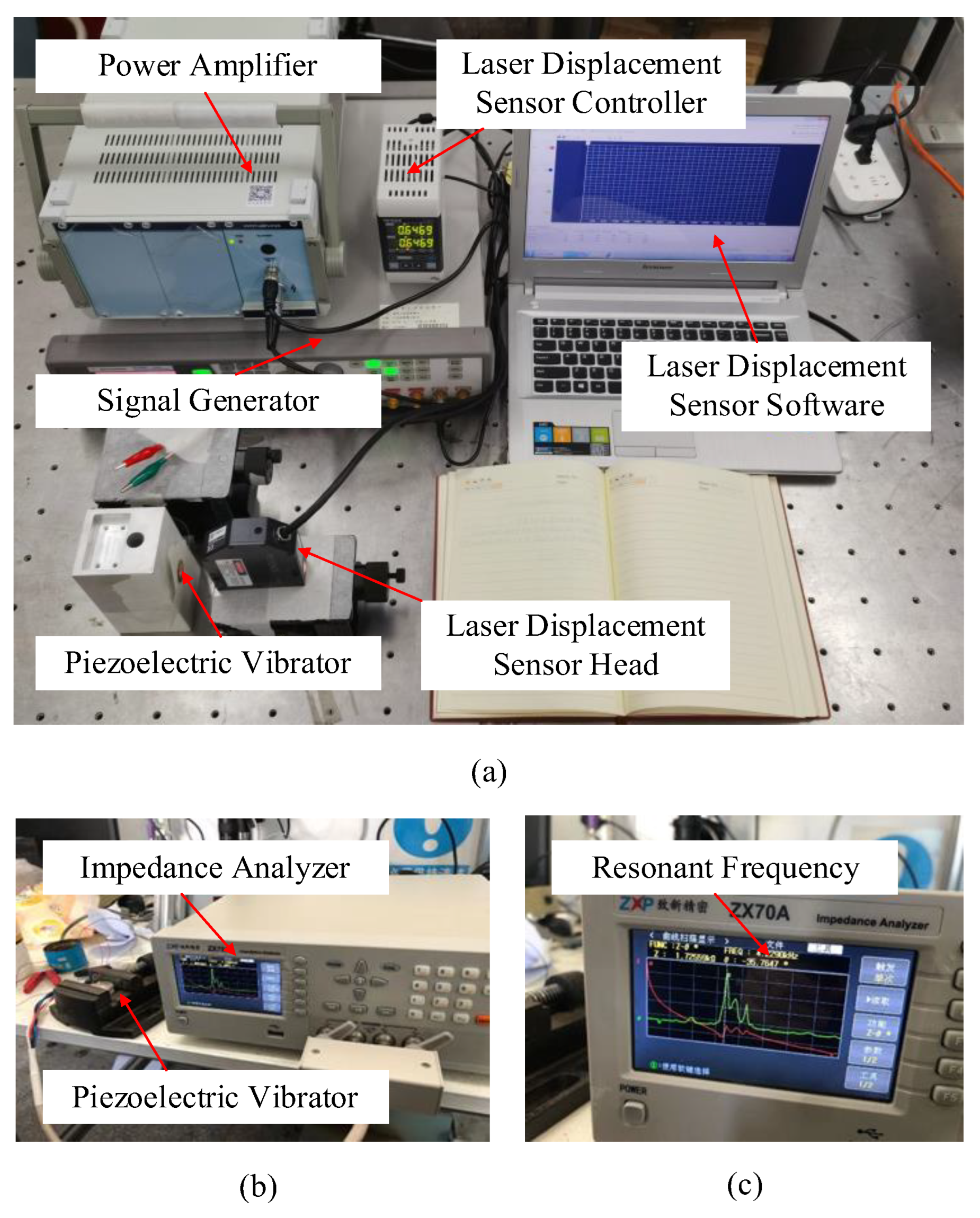

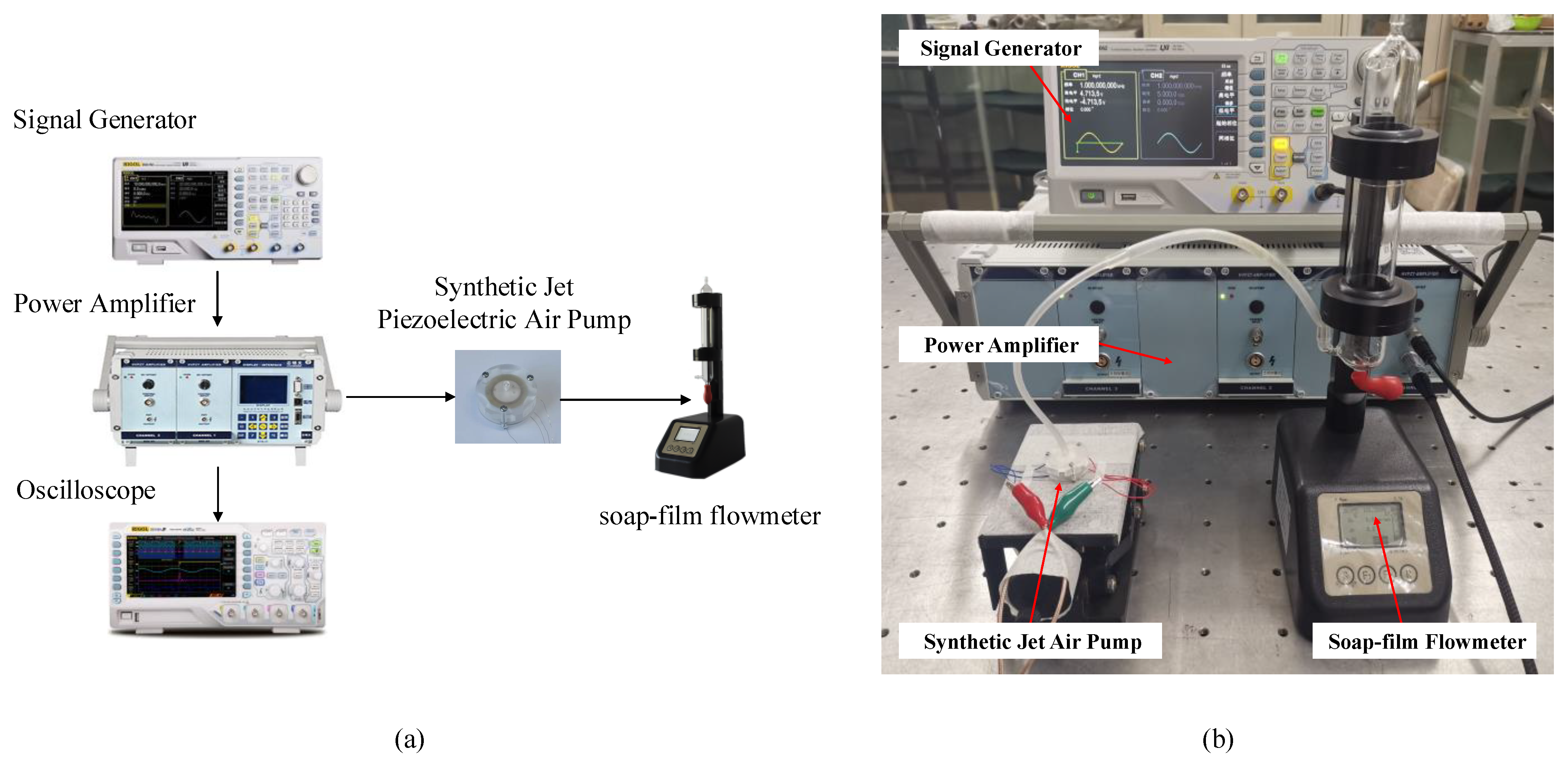

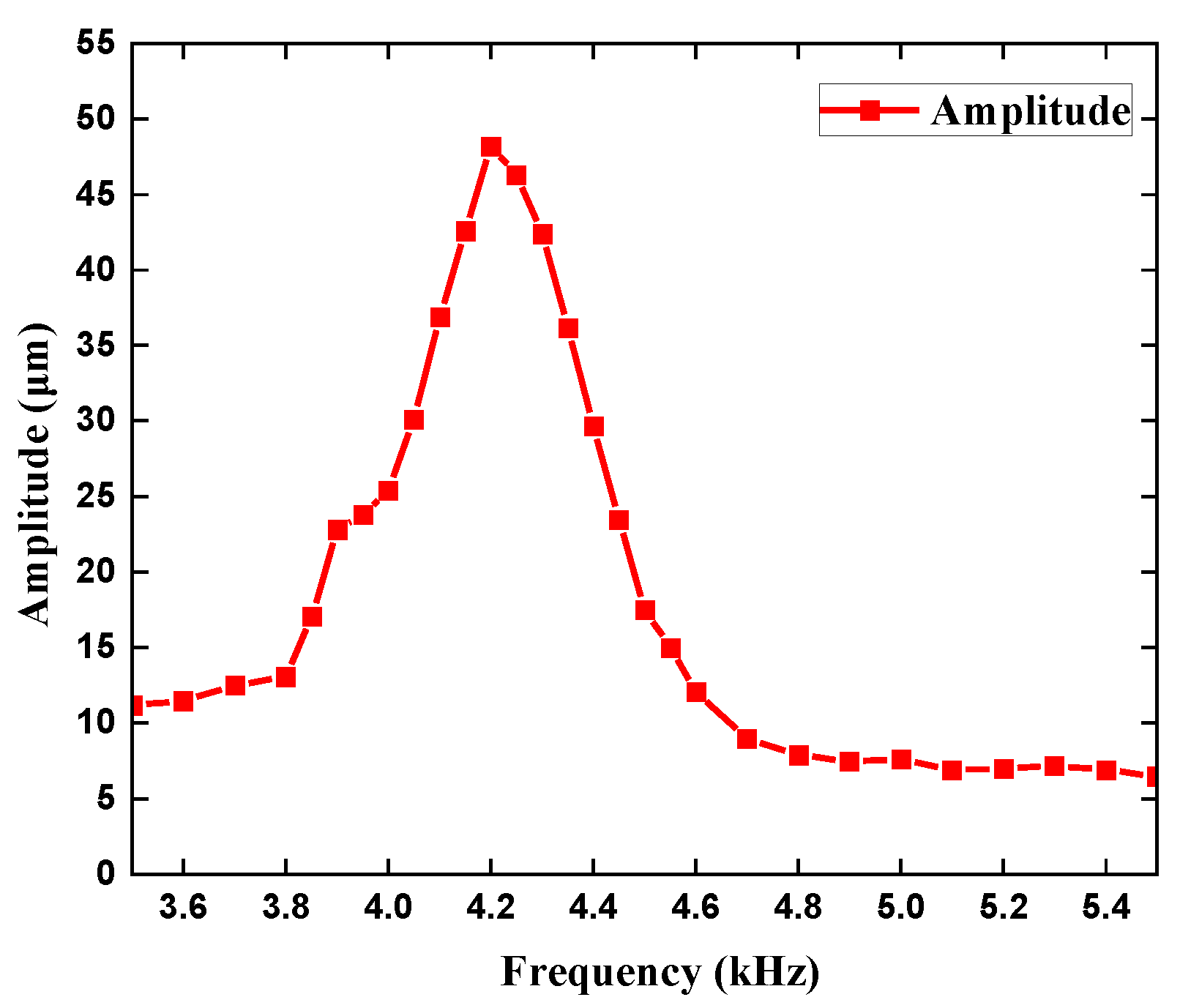
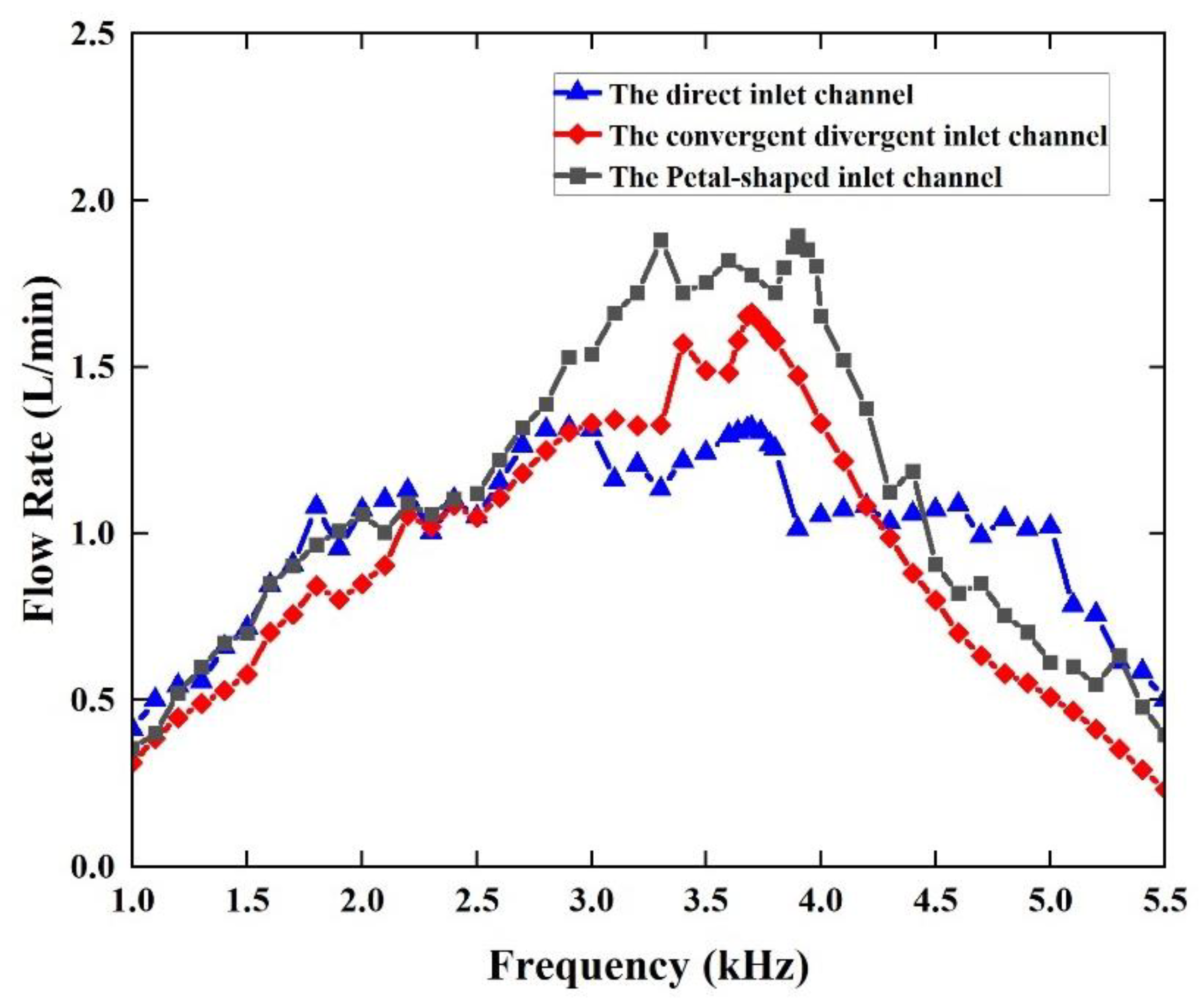
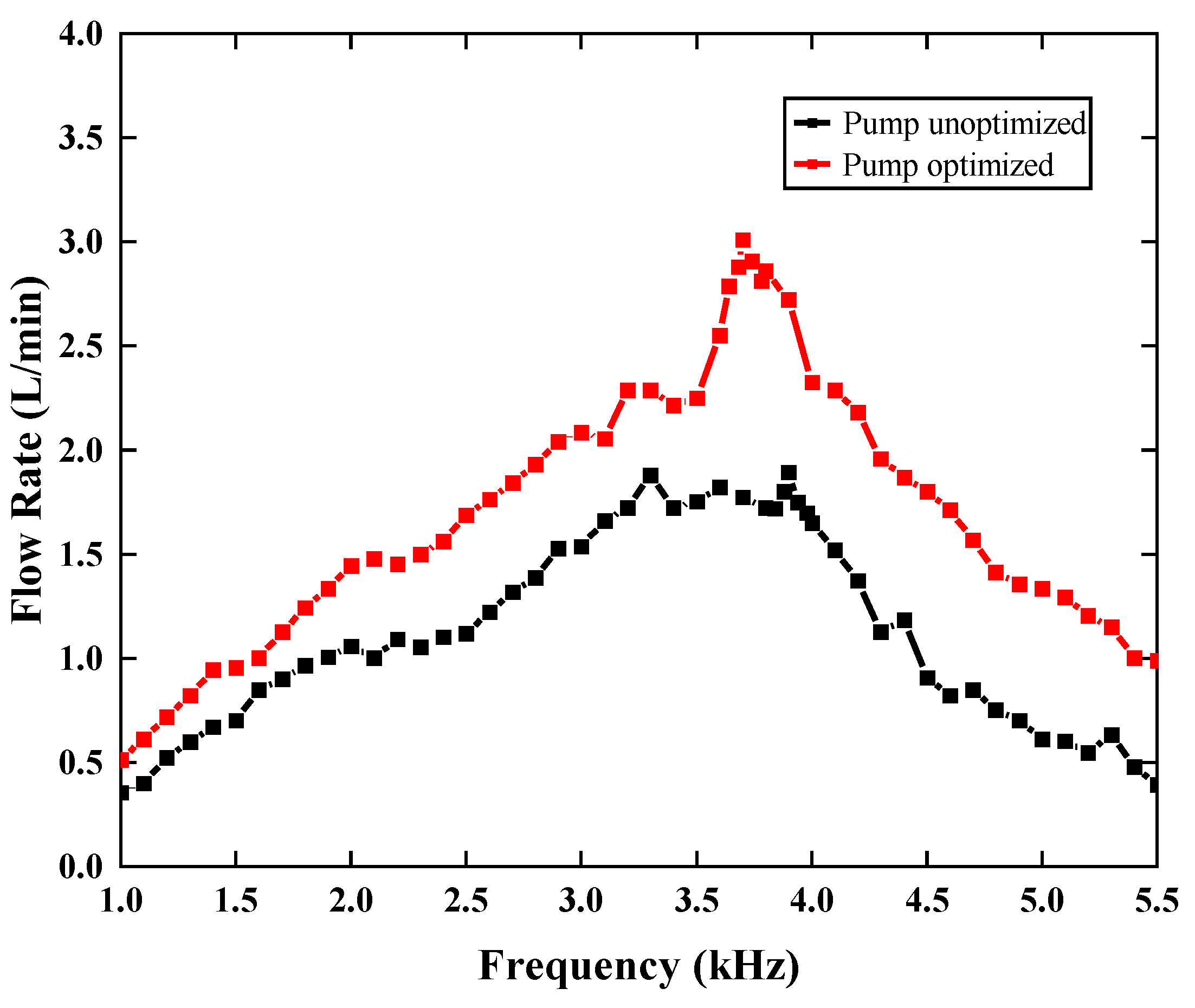

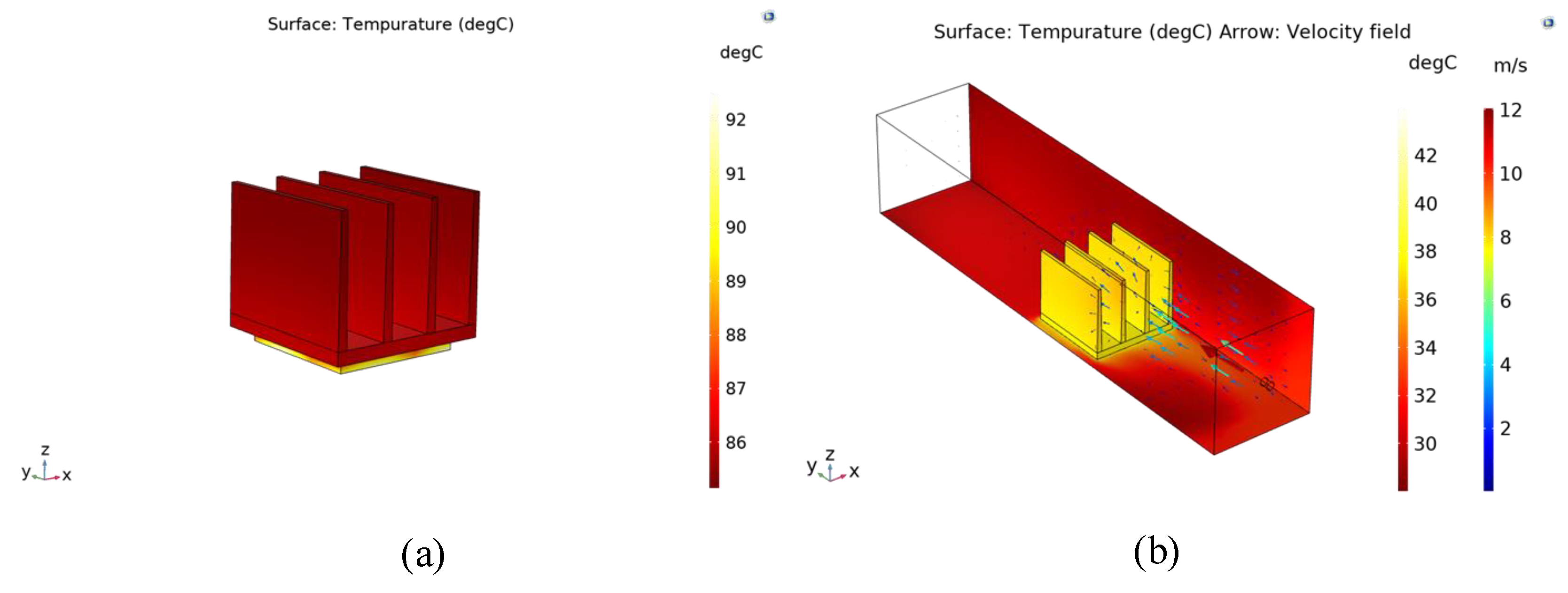
| Type | Material | Diameter (mm) | Thickness (mm) | Density (kg·m−3) | Modulus of Elasticity (GPa) | Poisson’s Ratio |
|---|---|---|---|---|---|---|
| Ceramic | PZT-5 | 14 | 0.2 | 7600 | 63 | 0.32 |
| Substrate | Copper | 20 | 0.2 | 8920 | 118 | 0.35 |
| Parameter | Symbol | Value (mm) |
|---|---|---|
| Diameter of piezoelectric pump | D | 28 |
| Height of piezoelectric pump | H | 10 |
| Diameter of air outlet | 1.0 | |
| Diameter of jet hole | 0.9 | |
| Height of cavity | 0.5 | |
| Height of pump chamber | 0.2 |
| Order | Resonant Frequency of Circular Piezoelectric Vibrator (Hz) | Resonant Frequency of Circular Piezoelectric Vibrator with Hole (Hz) |
|---|---|---|
| 1 | 4488.8 | 4470.7 |
| 2 | 9555.6 | 9553.9 |
| 3 | 9657.1 | 9655.7 |
| 4 | 15,332 | 15,306 |
| Level/Factors | ||||
|---|---|---|---|---|
| 1 | 0.8 | 0.6 | 0.4 | 0.1 |
| 2 | 0.9 | 0.7 | 0.5 | 0.2 |
| 3 | 1.0 | 0.8 | 0.6 | 0.3 |
| 4 | 1.1 | 0.9 | 0.7 | 0.4 |
| 5 | 1.2 | 1.0 | 0.8 | 0.5 |
| Group Number | Factors | Result Q (L/min) | Corresponding Frequency (kHz) | |||||
|---|---|---|---|---|---|---|---|---|
| Error List 1 | Error List 2 | |||||||
| 1 | 0.8 | 0.6 | 0.4 | 0.1 | 1 | 1 | 1.0547 | 3.9 |
| 2 | 0.8 | 0.7 | 0.5 | 0.2 | 2 | 2 | 1.2992 | 4.1 |
| 3 | 0.8 | 0.8 | 0.6 | 0.3 | 3 | 3 | 1.7536 | 3.9 |
| 4 | 0.8 | 0.9 | 0.7 | 0.4 | 4 | 4 | 1.1253 | 3.5 |
| 5 | 0.8 | 1 | 0.8 | 0.5 | 5 | 5 | 1.8682 | 3.7 |
| 6 | 0.9 | 0.6 | 0.5 | 0.3 | 4 | 5 | 1.3294 | 3.5 |
| 7 | 0.9 | 0.7 | 0.6 | 0.4 | 5 | 1 | 1.4583 | 3.9 |
| 8 | 0.9 | 0.8 | 0.7 | 0.5 | 1 | 2 | 1.9313 | 3.6 |
| 9 | 0.9 | 0.9 | 0.8 | 0.1 | 2 | 3 | 2.1987 | 3.9 |
| 10 | 0.9 | 1 | 0.4 | 0.2 | 3 | 4 | 1.4436 | 3.5 |
| 11 | 1 | 0.6 | 0.6 | 0.5 | 2 | 4 | 1.624 | 3.6 |
| 12 | 1 | 0.7 | 0.7 | 0.1 | 3 | 5 | 1.8805 | 3.7 |
| 13 | 1 | 0.8 | 0.8 | 0.2 | 4 | 1 | 2.0417 | 4.1 |
| 14 | 1 | 0.9 | 0.4 | 0.3 | 5 | 2 | 2.0564 | 3.6 |
| 15 | 1 | 1 | 0.5 | 0.4 | 1 | 3 | 2.2507 | 3.2 |
| 16 | 1.1 | 0.6 | 0.7 | 0.2 | 5 | 3 | 1.6618 | 4.2 |
| 17 | 1.1 | 0.7 | 0.8 | 0.3 | 1 | 4 | 3.0088 | 3.8 |
| 18 | 1.1 | 0.8 | 0.4 | 0.4 | 2 | 5 | 1.6715 | 3.9 |
| 19 | 1.1 | 0.9 | 0.5 | 0.5 | 3 | 1 | 2.1491 | 3.8 |
| 20 | 1.1 | 1 | 0.6 | 0.1 | 4 | 3 | 2.7751 | 3.7 |
| 21 | 1.2 | 0.6 | 0.8 | 0.4 | 3 | 2 | 2.9775 | 3.8 |
| 22 | 1.2 | 0.7 | 0.4 | 0.5 | 4 | 3 | 2.1819 | 3.6 |
| 23 | 1.2 | 0.8 | 0.5 | 0.1 | 5 | 4 | 2.0864 | 4.0 |
| 24 | 1.2 | 0.9 | 0.6 | 0.2 | 1 | 5 | 2.5985 | 4.1 |
| 25 | 1.2 | 1 | 0.7 | 0.3 | 2 | 1 | 2.4855 | 3.9 |
| K1 | 1.420 | 1.729 | 1.682 | 1.999 | 2.169 | 1.838 | ||
| K2 | 1.672 | 1.966 | 1.823 | 1.809 | 1.856 | 2.066 | ||
| K3 | 1.971 | 1.897 | 2.042 | 2.127 | 2.041 | 2.137 | ||
| K4 | 2.253 | 2.026 | 1.817 | 1.897 | 1.891 | 1.858 | ||
| K5 | 2.466 | 2.165 | 2.419 | 1.951 | 1.826 | 1.870 | ||
| R | 1.046 | 0.436 | 0.737 | 0.318 | 0.343 | 0.299 | ||
Publisher’s Note: MDPI stays neutral with regard to jurisdictional claims in published maps and institutional affiliations. |
© 2022 by the authors. Licensee MDPI, Basel, Switzerland. This article is an open access article distributed under the terms and conditions of the Creative Commons Attribution (CC BY) license (https://creativecommons.org/licenses/by/4.0/).
Share and Cite
Li, X.; Liu, X.; Dong, L.; Sun, X.; Tang, H.; Liu, G. A High-Performance Synthetic Jet Piezoelectric Air Pump with Petal-Shaped Channel. Sensors 2022, 22, 3227. https://doi.org/10.3390/s22093227
Li X, Liu X, Dong L, Sun X, Tang H, Liu G. A High-Performance Synthetic Jet Piezoelectric Air Pump with Petal-Shaped Channel. Sensors. 2022; 22(9):3227. https://doi.org/10.3390/s22093227
Chicago/Turabian StyleLi, Xingqi, Xiaopeng Liu, Luntao Dong, Xiaodong Sun, Huajie Tang, and Guojun Liu. 2022. "A High-Performance Synthetic Jet Piezoelectric Air Pump with Petal-Shaped Channel" Sensors 22, no. 9: 3227. https://doi.org/10.3390/s22093227
APA StyleLi, X., Liu, X., Dong, L., Sun, X., Tang, H., & Liu, G. (2022). A High-Performance Synthetic Jet Piezoelectric Air Pump with Petal-Shaped Channel. Sensors, 22(9), 3227. https://doi.org/10.3390/s22093227





